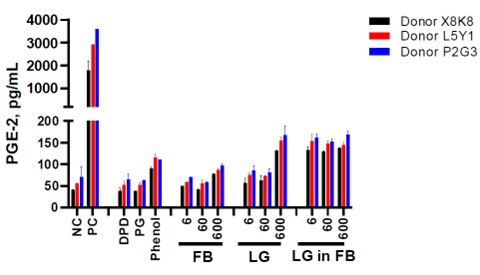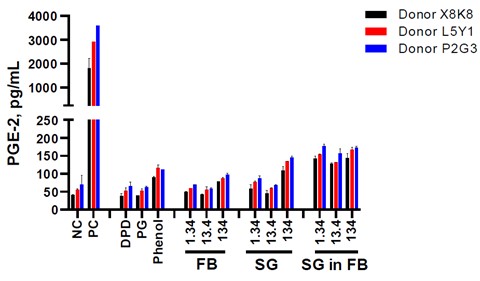Bioanalytics - Biomolecular
Category: Late Breaking Poster Abstract
(M1130-06-38) Innate Immune Response Modulating Impurities Assay for Assessing Synthetic Semaglutide and Liraglutide
Monday, October 23, 2023
11:30 AM - 12:30 PM ET
- JL
Jennifer Lee, Ph.D.
US Food and Drug Administration
Silver Springs, Maryland, United States 
Eric Pang, Ph.D.
Senior Chemist
US Food and Drug Administration
Silver Spring, Maryland, United States
Marina Dobrovolskaia, Ph.D.
Laboratory Director; Section Head
Nanotechnology Characterization Laboratory
Bethesda, Maryland, United States- CH
Claire Holley, Ph.D.
Nanotechnology Characterization Laboratory
Bethesda, Maryland, United States
Presenting Author(s)
Main Author(s)
Co-Author(s)
Purpose: To facilitate generic peptide submission and approval, the FDA published guidance on ANDAs for Certain Highly Purified Synthetic Peptide Drug Products That Refer to Listed Drugs of rDNA Origin (May 2021) provides FDA’s recommendations for demonstrating the equivalence of synthetically produced generic peptide drug products that reference a recombinantly produced reference listed drug (RLD). Although the guidance is specific for glucagon, liraglutide, nesiritide, teriparatide, and teduglutide, FDA has other peptide products where the product-specific guidances (PSGs) reference this peptide guidance. A critical aspect in the development and approval of these peptide products is the need for an immunogenicity risk assessment. This risk is informed by the RLD’s clinical experience as well as specific quality aspects of the peptide. If the immunogenicity risk of the RLD peptide is considered to be elevated, additional non-clinical assays (e.g., cell-based or functional binding assays) may be needed for generic applicants to demonstrate that their product will not further elevate the immunogenicity risk. To facilitate the development of these non-clinical immunogenicity assays, we examined commonly used assays for detecting innate immune response mediated impurities (IIRMIs), including cytokine secretion by peripheral blood mononuclear cells (PBMCs). In this study, we present the findings on the induction of cytokines in the presence of liraglutide (LG) and semaglutide (SG).
Methods: PBMCs isolated from the freshly drawn whole blood of 10 healthy donors were incubated with 10 innate immune response modulating impurities (IIRMIs) from various sources in combination with either 600 µg/mL LG or 134 µg/mL SG for 24 hours. LG, SG, and formulation buffer (FB) at three concentrations were further diluted in PBS or FB, as well as the individual FB components (disodium phosphate dihydrate (DPD), propylene glycol (PG), and phenol) alone at concentrations equivalent to that which would be present in the highest used concentration of active pharmaceutical ingredient (API). At the end of incubation, the samples were centrifuged for 5 min at 18,000xg, and supernatants were analyzed for the presence of cytokines using custom 16-plex enzyme linked immunosorbent assay (ELISA) from Quansys Biosciences (Logan, UT, USA).
Results: LG and SG did not interfere with cytokine detection when employing these multiplex ELISAs (Tables 1 and 2). LG induced prostaglandin E2 (PGE-2) in all tested cultures. The study demonstrated that PGE-2 responses to LG as well as the suppression of IIRMI-induced cytokines by LG were due to the FB (Figure 1). Further evaluation was performed to determine which of the FB components, including DPD, PG, and phenol, was responsible for the observed cytokine effects. From this experiment, we observed that the phenol component of the FB was responsible for the induction of PGE-2. SG induced PGE-2, albeit at low levels, in a concentration-dependent manner in 80% of all tested cultures (Figure 2). However, for a couple of donors, there was no detectable induction of PGE-2 even at the highest concentration of SG, indicating that there is no ideal signature cytokine for SG. The experiment showed that PGE-2 responses to SG as well as the suppression of IIRMI-induced cytokines by SG were also due to the FB. Further experiment again demonstrated that the phenol component of the FB was responsible for the induction of PGE-2.
Conclusion: The key findings from the current study include the following: 1) LG and SG do not interfere with multiplex assays as evident by acceptable inhibition enhancement controls (IECs); 2) PGE-2 is a signature cytokine for LG, but is suboptimal for SG as it was only detected in cultures of 8 out of 10 donors; 3) PGE-2 induction by LG and SG is induced by the FB, specifically the phenol component, rather than the API; 4) IIRMIs induced a broad and often overlapping cytokine response consistent with the current knowledge of their cognate pattern recognition receptors (PRRs) and relevant signal transduction pathways; 5) the presence of LG or SG in cell cultures altered cytokines responses to IIRMIs; the most common effect was an inhibition of the IIRMI-induced cytokines; some cytokines and IIRMIs were affected more than others; donor- and concentration-dependent effects were also observed. To ensure the integrity of cell-based assays during development and validation, it is important for drug developers to investigate potential interference and evaluate its impact on cytokine signals. However, conducting and validating non-clinical immunogenicity assays can be challenging due to the lack of standardized approaches and best practices. Collaboration among regulatory bodies, industry, and academia is encouraged to develop standardized methods for these in vitro assays.
Acknowledgements: This research was supported by federal funds from the U.S. Food and Drug Administration, Center for Drug Evaluation and Research/Office of Generic Drugs, under an Inter-Agency Agreement with NCL/NCI/NIH (IAA #224-19-3008S). Dr. Lee was supported by an appointment to the Oak Ridge Institute for Science and Education (ORISE) Research Participation Program at the CDER administered by the ORISE through an agreement between the U. S. Department of Energy and CDER. The views expressed in this poster do not necessarily reflect the official policies of the Department of Health and Human Services; nor does any mention of trade names, commercial practices, or organization imply endorsement by the United States Government.
 Table 1: Liraglutide affects innate immunity modulating impurity-induced cytokines. Individual IIMIs, their cognate PRRs, and cytokines induced by the presence of 600 µg/mL of LG and in combination with IIRMIs, are summarized in the table. All cytokines shown in the table are inhibited, except for the cytokines highlighted with an asterisk (*); levels of these cytokines are higher in the presence of LG. Statistical analysis included a 2-sided Wilcoxon test.
Table 1: Liraglutide affects innate immunity modulating impurity-induced cytokines. Individual IIMIs, their cognate PRRs, and cytokines induced by the presence of 600 µg/mL of LG and in combination with IIRMIs, are summarized in the table. All cytokines shown in the table are inhibited, except for the cytokines highlighted with an asterisk (*); levels of these cytokines are higher in the presence of LG. Statistical analysis included a 2-sided Wilcoxon test. Figure 1: The phenol component of the formulation buffer induces prostaglandin-E2 cytokine response to liraglutide. PBMCs from three healthy donors were used to quantify induction of PGE-2 in response to the individual components of FB - including DPD, PG, and phenol - at concentrations equivalent to 600 µg/mL of API in LG, in comparison to complete FB, LG, and LG diluted in FB. Each sample was tested in duplicate. Each bar shows a mean response and a standard deviation (N=2).
Figure 1: The phenol component of the formulation buffer induces prostaglandin-E2 cytokine response to liraglutide. PBMCs from three healthy donors were used to quantify induction of PGE-2 in response to the individual components of FB - including DPD, PG, and phenol - at concentrations equivalent to 600 µg/mL of API in LG, in comparison to complete FB, LG, and LG diluted in FB. Each sample was tested in duplicate. Each bar shows a mean response and a standard deviation (N=2). Figure 2: The phenol component of the formulation buffer induces prostaglandin-E2 cytokine response to semaglutide. PBMCs from three healthy donors were used to quantify induction of PGE-2 in response to the individual components of FB - including DPD, PG, and phenol - at concentrations equivalent to 134 µg/mL of API in SG, in comparison to complete FB, SG, and SG diluted in FB. Each sample was tested in duplicate. Each bar shows a mean response and a standard deviation (N=2).
Figure 2: The phenol component of the formulation buffer induces prostaglandin-E2 cytokine response to semaglutide. PBMCs from three healthy donors were used to quantify induction of PGE-2 in response to the individual components of FB - including DPD, PG, and phenol - at concentrations equivalent to 134 µg/mL of API in SG, in comparison to complete FB, SG, and SG diluted in FB. Each sample was tested in duplicate. Each bar shows a mean response and a standard deviation (N=2).